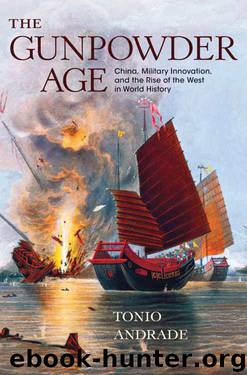The Gunpowder Age: China, Military Innovation, and the Rise of the West in World History by Tonio Andrade

Author:Tonio Andrade [Andrade, Tonio]
Language: eng
Format: epub, azw3
Publisher: Princeton University Press
Published: 2016-01-11T18:30:00+00:00
Experimental Science and European Warcraft
Today many prominent historians downplay the role of science in the rise of the West, and the topic has aroused considerable discussion.45 As usual most of this debate has focused on economic history, and it’s been hard for either side to sway the other, largely because the links between science and economic growth are difficult to pin down for the period when the Great Divergence was opening up, to wit the 1700s.
But if the links between science and eighteenth-century economies remain unclear, there’s no doubt about the links between science and the eighteenth century military divergence. European advances in gunpowder manufacture and gun design were based on discoveries from experimental science, and those advances played a key role in the British victory in the Opium War.
Before the mid-eighteenth century, people did not understand some very basic things about guns and gunpowder. What was the precise relationship between the amount of gunpowder used, the shape of the barrel, and the velocity of a projectile of a given mass and size? How much air resistance did the projectile face once it exited the barrel, and how did that resistance affect the trajectory?
In the seventeenth century, Galileo and others had developed a theory of ballistics and put together tables to help artillerists—Galileo had even developed instruments for aiming cannons, which brought him significant income.46 Over the ensuing generations, others had refined these tables and instruments, but by the mid-eighteenth century these tools were still inaccurate, useful for a limited range and only in certain conditions.
In order to develop more effective models one needed to know how fast projectiles came out of guns. It wasn’t an easy problem. Enter Benjamin Robins (1707–1751). A disciple of Isaac Newton, Robins developed an instrument that transformed the science of guns: the ballistic pendulum. It was a tripod the height of a tall man with a heavy pendulum hanging down from it. On the pendulum was affixed a target. The experiment started with the pendulum at rest. When struck by a projectile, the pendulum swung upward. By measuring how high it went one could determine the projectile’s momentum, and using Newtonian models one could calculate its velocity.
The ballistics pendulum revolutionized gunnery. The most exciting findings had to do with the effect of air pressure on projectiles. Galileo had dismissed the effects of air pressure in his work on ballistics, and Newton, too, underestimated it, or, rather, expected that its effects were linear at increasing speeds. But Robins showed that air resistance was incredibly significant. Whereas then-current models predicted that a twenty-four-pound cannonball should, at the muzzle velocity Robins had measured, fly sixteen miles, in actuality it flew only three. Air resistance was thus much higher than expected. Even more surprising was the nonlinearity of the results. The higher the muzzle velocity, the greater the effect, with extreme drag as you approached the speed of sound.47 His research thus revealed a hitherto invisible threshold: the speed of sound, at which air resistance increased greatly. No one could have predicted this phenomenon.
Download
The Gunpowder Age: China, Military Innovation, and the Rise of the West in World History by Tonio Andrade.azw3
This site does not store any files on its server. We only index and link to content provided by other sites. Please contact the content providers to delete copyright contents if any and email us, we'll remove relevant links or contents immediately.
| Biological & Chemical | Conventional |
| Nuclear |
The Radium Girls by Kate Moore(11921)
100 Deadly Skills by Clint Emerson(4840)
Rise and Kill First by Ronen Bergman(4701)
The Templars by Dan Jones(4627)
The Doomsday Machine by Daniel Ellsberg(4415)
The Rape of Nanking by Iris Chang(4136)
Killing England by Bill O'Reilly(3951)
Hitler in Los Angeles by Steven J. Ross(3900)
Stalin by Stephen Kotkin(3875)
12 Strong by Doug Stanton(3508)
Hitler's Monsters by Eric Kurlander(3268)
Blood and Sand by Alex Von Tunzelmann(3138)
The Code Book by Simon Singh(3073)
Darkest Hour by Anthony McCarten(3070)
The Art of War Visualized by Jessica Hagy(2943)
Hitler's Flying Saucers: A Guide to German Flying Discs of the Second World War by Stevens Henry(2714)
Babylon's Ark by Lawrence Anthony(2620)
The Second World Wars by Victor Davis Hanson(2480)
Tobruk by Peter Fitzsimons(2442)
